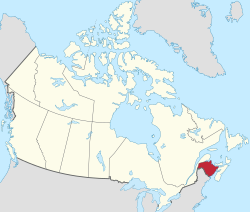Colony of New Brunswick
New Brunswick
|
|||
|---|---|---|---|
|
|||
| Motto: Latin: Spem reduxit ("Hope restored") |
|||
| Confederation | July 1, 1867 (1st, with ON, QC, NS) | ||
| Capital | Fredericton | ||
| Largest city | Moncton | ||
| Largest metro | Greater Moncton | ||
| Government | |||
| • Type | Constitutional monarchy | ||
| • Lieutenant Governor | Jocelyne Roy-Vienneau | ||
| • Premier | Brian Gallant (Liberal) | ||
| Legislature | Legislative Assembly of New Brunswick | ||
| Federal representation | (in Canadian Parliament) | ||
| House seats | 10 of 338 (3%) | ||
| Senate seats | 10 of 105 (9.5%) | ||
| Area | |||
| • Total | 72,908 km2 (28,150 sq mi) | ||
| • Land | 71,450 km2 (27,590 sq mi) | ||
| • Water | 1,458 km2 (563 sq mi) 2% | ||
| Area rank | Ranked 11th | ||
| 0.7% of Canada | |||
| Population (2016) | |||
| • Total | 747,101 | ||
| • Estimate (2017 Q1) | 757,771 | ||
| • Rank | Ranked 8th | ||
| • Density | 10.5/km2 (27/sq mi) | ||
| Demonym(s) | New Brunswicker FR: Néo-Brunswickois(e) |
||
| Official languages | |||
| GDP | |||
| • Rank | 9th | ||
| • Total (2011) | C$32.180 billion | ||
| • Per capita | C$42,606 (11th) | ||
| Time zone | Atlantic: UTC-4 | ||
| Postal abbr. | NB | ||
| Postal code prefix | E | ||
| ISO 3166 code | CA-NB | ||
| Flower | Purple violet | ||
| Tree | Balsam fir | ||
| Bird | Black-capped chickadee | ||
| Website | www |
||
| Rankings include all provinces and territories | |||
New Brunswick (French: Nouveau-Brunswick; Canadian French pronunciation: [nuvobʁɔnzwɪk]) is one of Canada's three Maritime provinces (together with Prince Edward Island and Nova Scotia) and is the only constitutionally bilingual (English–French) province. The principal cities are Fredericton, the capital, Greater Moncton, currently the largest metropolitan (CMA) area and the most populous city, and the port city of Saint John, which was the first incorporated city in Canada and largest in the province for 231 years until 2016.
In the Canada 2016 Census, Statistics Canada estimated the provincial population to have been 747,101, down very slightly from 751,171 in 2011, on an area of almost 73,000 km2. The majority of the population is English-speaking of Anglo and Celtic heritage, but there is also a large Francophone minority (33%), chiefly of Acadian origin. It was created as a result of the partitioning of the British colony of Nova Scotia in 1784 and was originally named New Ireland with the capital to be in Saint John. The name was soon replaced with New Brunswick by King George II. The provincial flag features a ship superimposed on a yellow background with a yellow lion passant guardant on red pennon above it.
The province is named for the city of Braunschweig, known in English and Low German (the language originally spoken in the area) as Brunswick, located in modern-day Lower Saxony in northern Germany (and also the former duchy of the same name). The then-colony was named in 1784 to honour the reigning British monarch, George III, who was concurrently Duke and prince-elector of Brunswick-Lüneburg ("Hanover") in the Holy Roman Empire of the German Nation.
...
Wikipedia



